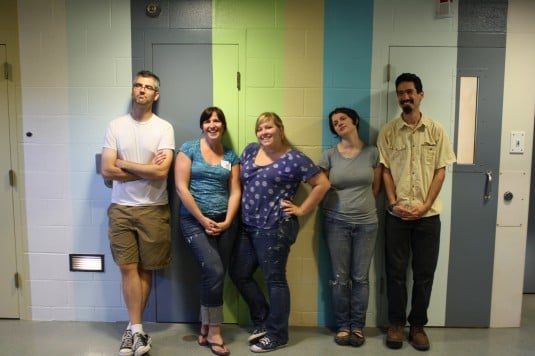
January 23, 2012
All Together Now: VI
We asked our MFA students to dream big, and then build their design for a literacy center for a juvenile detention center—in 10 days! We decided to pair unlimited imagination with pragmatic requirements to see if we could help the students realize the fantastic, while making the everyday something to aspire to. Our strategy for […]
We asked our MFA students to dream big, and then build their design for a literacy center for a juvenile detention center—in 10 days! We decided to pair unlimited imagination with pragmatic requirements to see if we could help the students realize the fantastic, while making the everyday something to aspire to. Our strategy for this dual directive was that one (the fantastic) would be a safeguard against the potential limitation or weakness of the other (pragmatism). Keep in mind that these were students with a wide range of backgrounds in art, craft, and design as well as various levels of skills. We were looking for a synthesis across disciplines.


MFA AC+D students, shown here at the end of installation, come from a wide range of art, craft and design backgrounds, including woodworking, furniture design, ceramics, sculpture, industrial design, architecture, textile design, interior design, metal-smithing, printmaking, painting, illustration, book arts, and graphic design.
Following the principle of ‘the more specific, the more universal’, our design-build project stressed specificity in developing an understanding a complex and wide-ranging problem. And what could be more complex than the potential for rehabilitating the incarcerated? Working closely with them, their environment, being mindful of our resources–and knowing that we fully intend to make the project happen–-we prioritized the project’s identity and our accountability over other values commonly associated with global problem-solving, such as scalability and innovation.
As design thinking strategies are increasingly used to solve, or at least alleviate, critical societal problems, we may want to rethink the design-build process. We need to develop a direct and deep understanding of systems that help define the problems we’re hoping to solve, for the sake of those who would be affected by our solutions.
Today’s design students and professionals are adept at generating compelling and inventive images that depict solutions to serious, multi-faceted problems. Frequently, however, designers’ responses lack a thorough foresight of the potential impact of innovation, in much the same way that the critical problems we face can be seen as partial consequences of past innovations.
While the ability to imagine what does not yet exist is valuable, there appears to be a plethora of “game-changing” ideas that seem to show an addiction to “innovation”, rather than improving our present and future state. It is almost as if the representation of a transformative idea is our primary design goal. I have, in fact, observed this while teaching design on the rapidly transforming Arabian Gulf: Once a project was conceived and rendered in 3D animation, it was basically considered to be real.
Designers who help us see ourselves behaving well and feeling good in healthy and supportive environments provide a map for achieving positive change. There is a danger, however, that design strategies that invest in the power of suggestion may be mere wishful thinking, and are generally as effective as fad diets.
When we invest in community-based design-build efforts and see these through to their successful completion, we understand the potential of robust and diverse solutions and their rewards. Creative discoveries occur when making things is easily integrated into a project, potentially providing distinctive character and improved function.
An intense, collaborative approach assembles the expertise of all involved, as well as develops relationships that lead to commitment and follow-through. The on-the-ground, present-centered, and tangible nature of the process also offers an opportunity to appreciate what design can do, by those otherwise indifferent to design.
Design-build can be exceptionally rewarding. Here’s how visiting artist Butch Anthony describes his experience: “I have to admit I was a little concerned going into the project. I thought ‘Oh Lord, I might get stabbed working in this place… working with inmates’. And I did get stabbed. I got stabbed right in the heart by how nice the four young boys we met there were. I was also moved by how hardworking the students from Oregon College of Art and Craft and the Pacific Northwest College of Art were. They really put all they had into the project even though they had limited resources and short time to build a creative library for the inmates.”

Visiting artist Jack Sander’s expression at the end of installation day says it all.
Everyone involved in this project has expressed a similar sense of appreciation for the work of our students – and the gravity of the incarcerated youths’ situation. We have discussed a potential second phase of the literacy center at Donald E. Long, as well as other opportunities to improve the rehabilitation process through design. This project has shown us that design can truly make a difference—especially to designers who participate making their abstract ideas real.
For a more detailed description of the project, please look here.
Series Posts:
JP Reuer is an architect and Chair of the MFA in Applied Craft and Design, a program collaboratively developed and offered jointly by Oregon College of Art and Craft and Pacific Northwest College of Art. Follow JP on Twitter at @jumpyreuer.





